Assessment of Spatial-Temporal Expansion of Built-up and Residential-Commercial Dwellings with Some Economic Implications: A Case Study in the Lower Hunter of Eastern Australia
Abstract
:1. Introduction
2. Materials and Methods
2.1. Study Area and Background
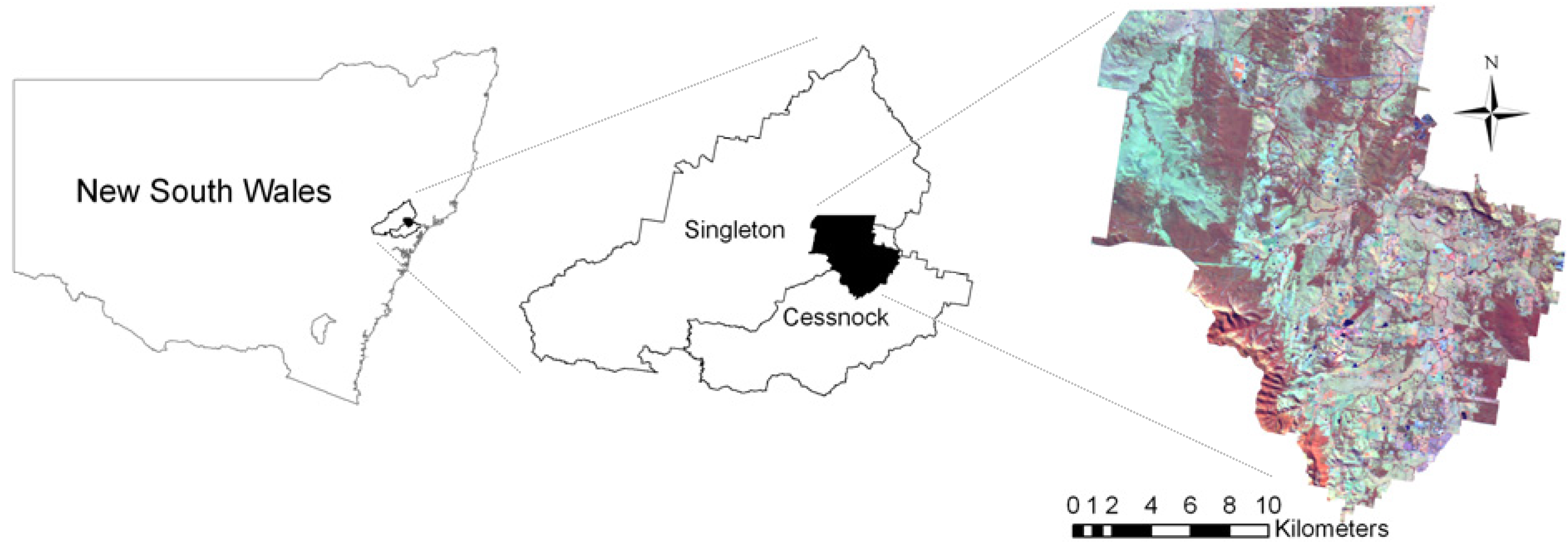
2.2. Data
| LULC Category | Description |
|---|---|
| Woodland | Forest covers including tree cover along the creeks |
| Pasture/scrubland | Natural and cultivated pastures, and scrubs with partial grassland |
| Vineyard | Irrigated and non-irrigated vineyards |
| Build-up | Commercial, and residential areas, and other areas with man-made structure; roads, railway lines |
| Water-body | Farm dams, sewage ponds |
| Mine/quarry | Mining areas |
| Olive | Olive groves (for 2005 only) |
2.3. Testing for Performance of the Simulation Model and Prediction of Built-up to 2025


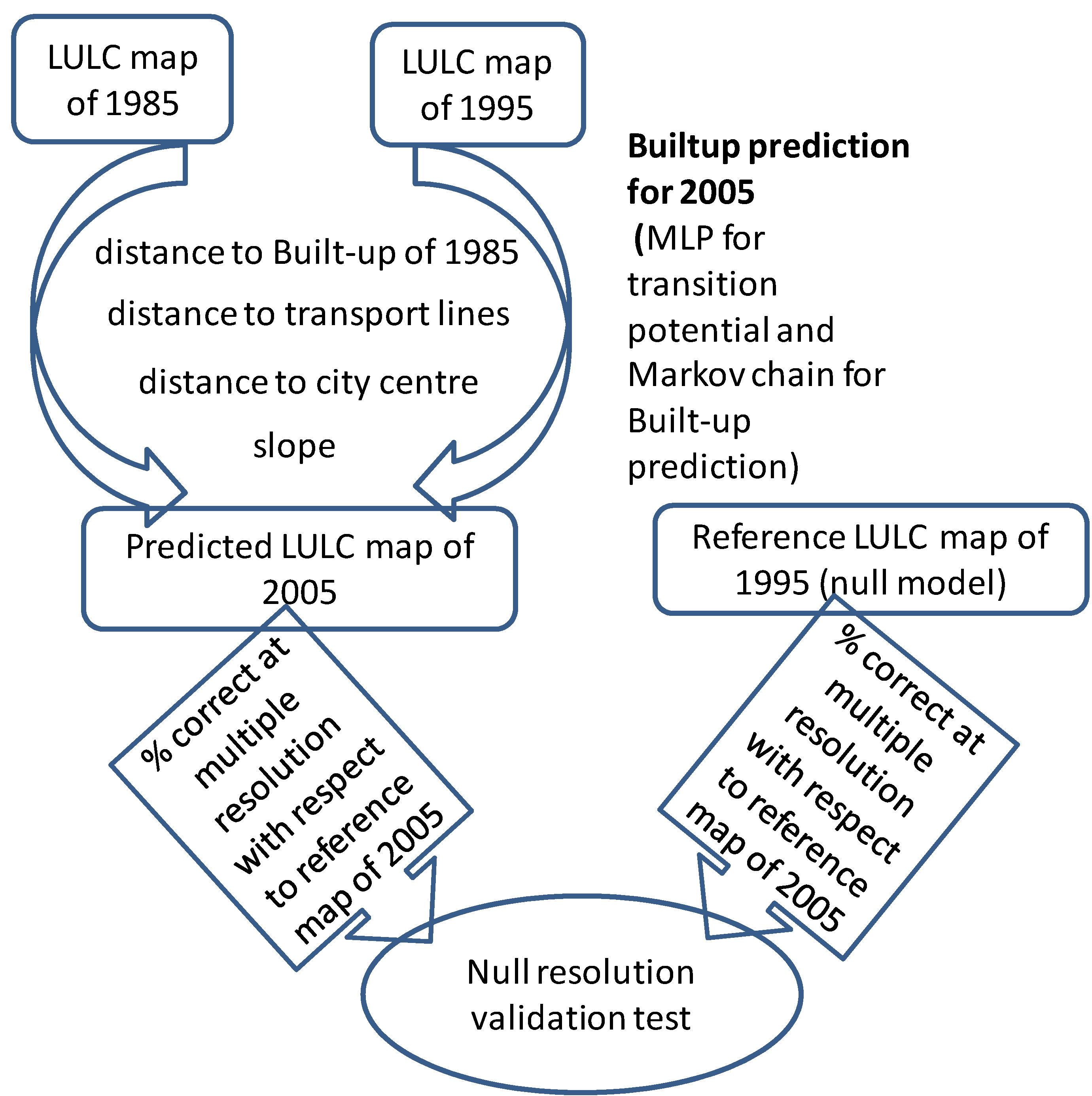
2.4. Extraction of Residential and Commercial Dwelling Density
2.5. Relating the Economic Information with the Growth in Residential and Commercial Dwelling Density
3. Results and Discussion
3.1. Trend in Built-up Area from 1985 to 2005
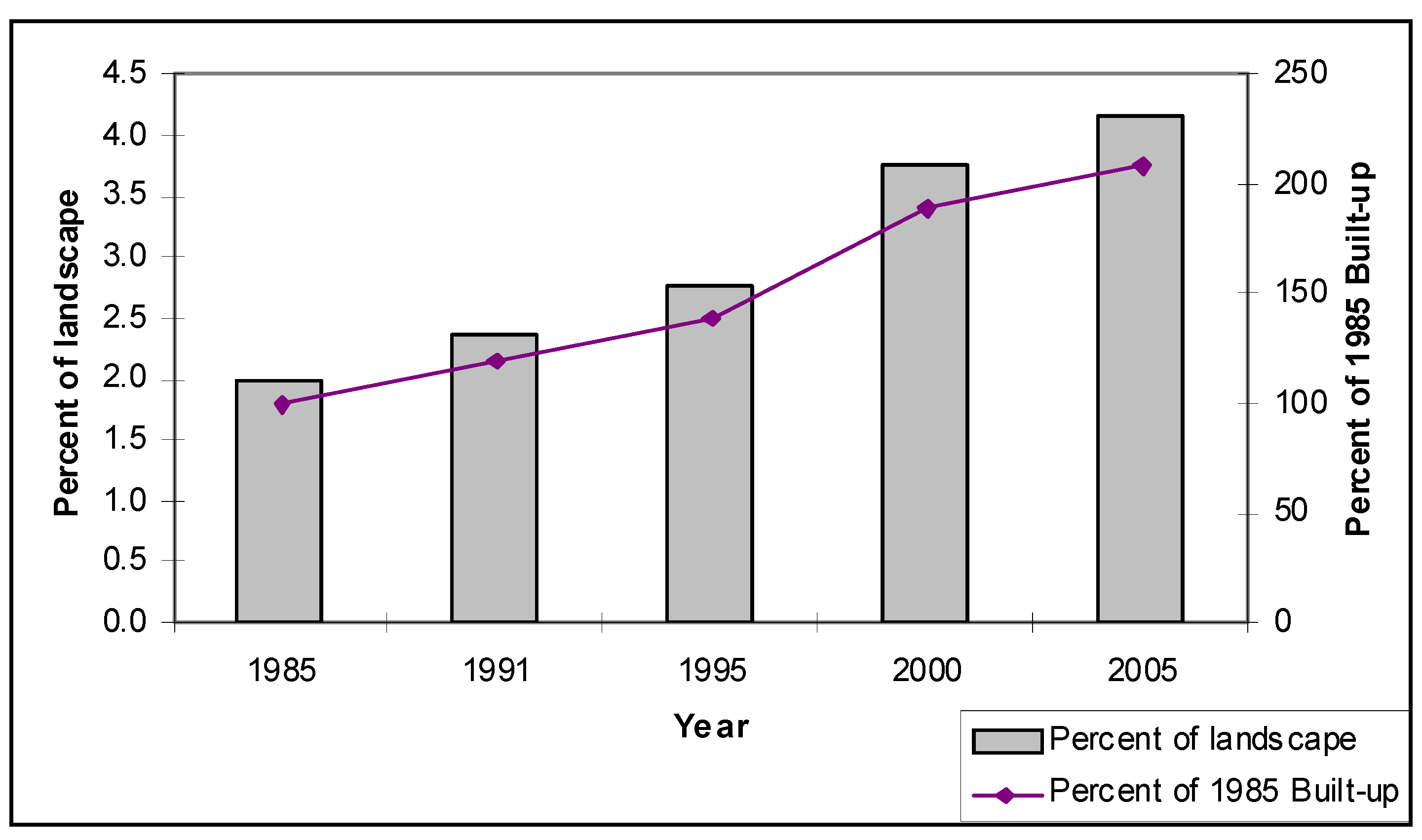
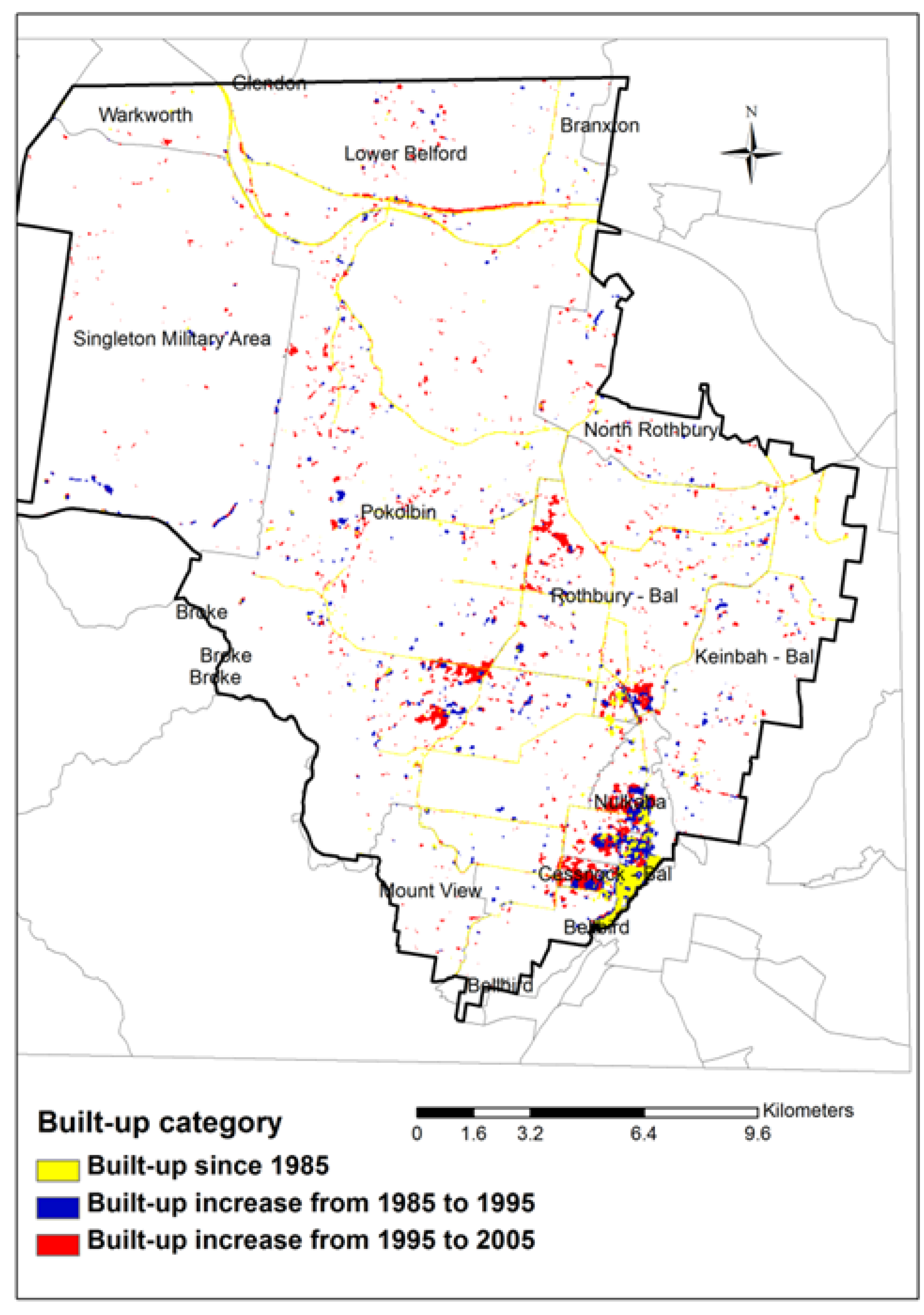
3.2. Model Validation and Prediction of Built-up to 2025
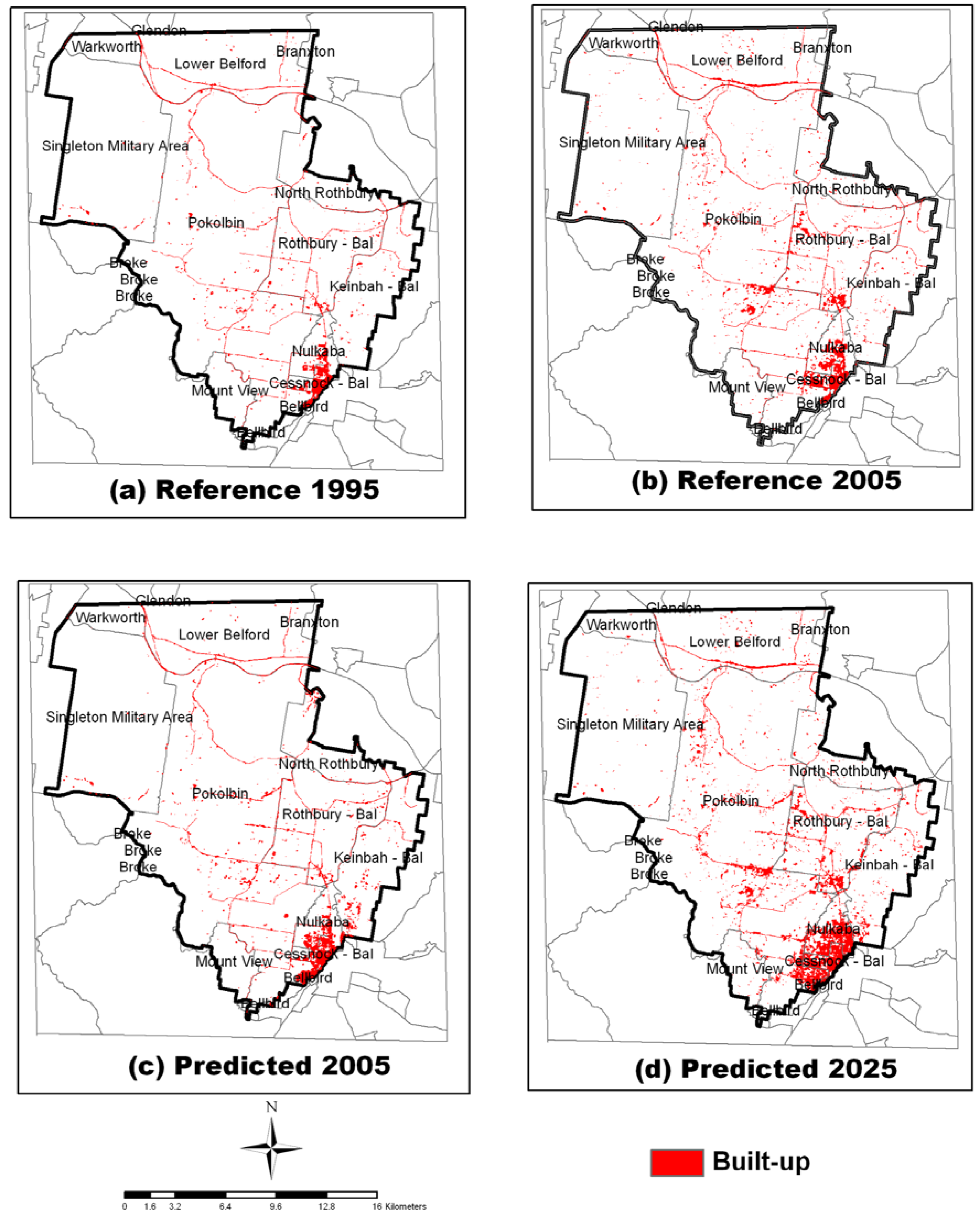
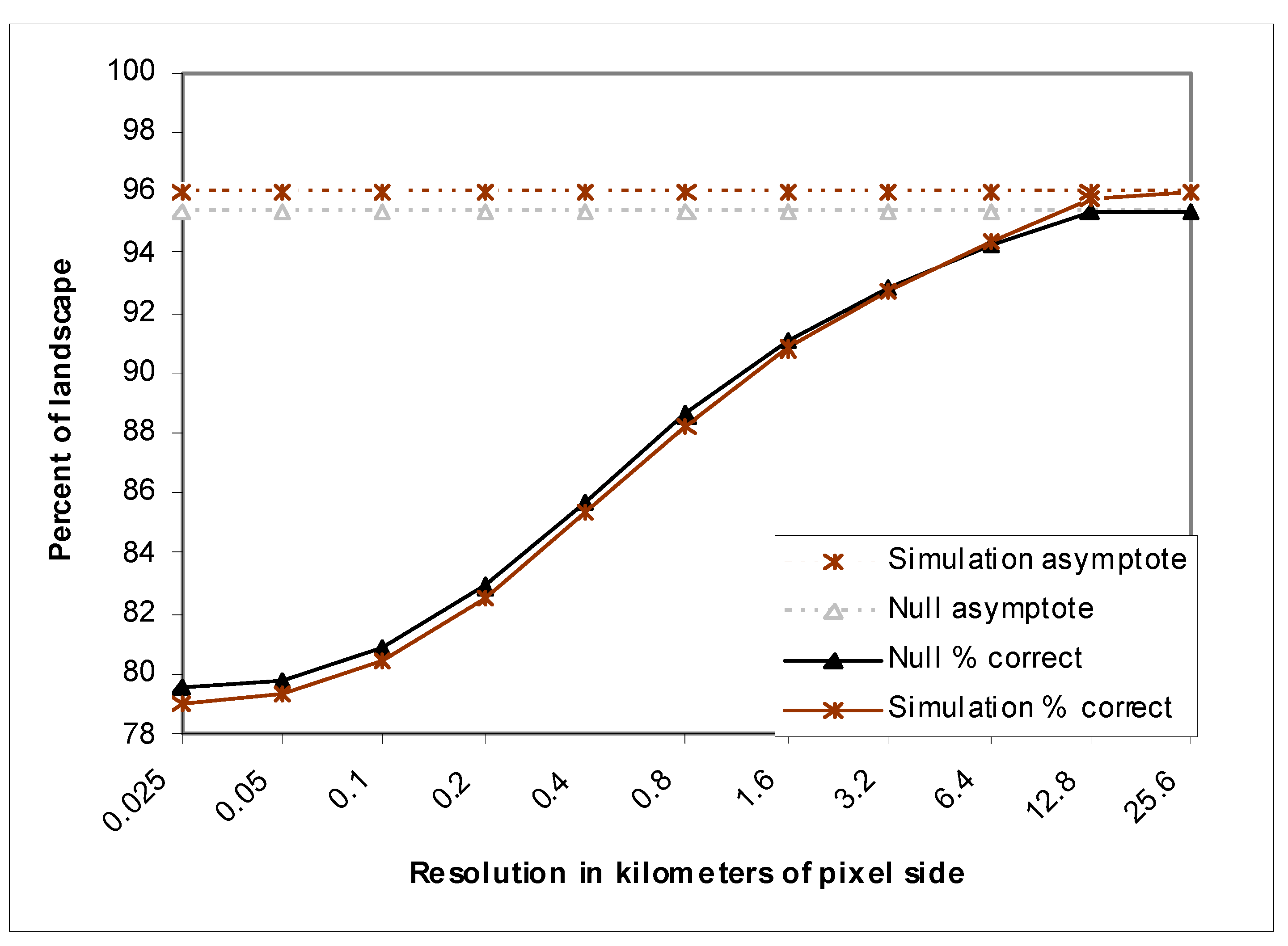
3.3. Residential and Commercial Dwelling Density Derived from Aerial Photos

| Year | Dwelling Density (units/km2) | |||||
|---|---|---|---|---|---|---|
| 0 | 0–10 | 10–25 | 25–50 | 50–100 | >100 | |
| 1985 | 59.0 | 35.7 | 4.2 | 0.5 | 0.2 | 0.4 |
| 1995 | 47.0 | 39.3 | 11.0 | 1.3 | 0.6 | 0.7 |
| 2005 | 40.0 | 36.0 | 15.6 | 5.5 | 1.2 | 1.7 |
3.4. Economic Implications
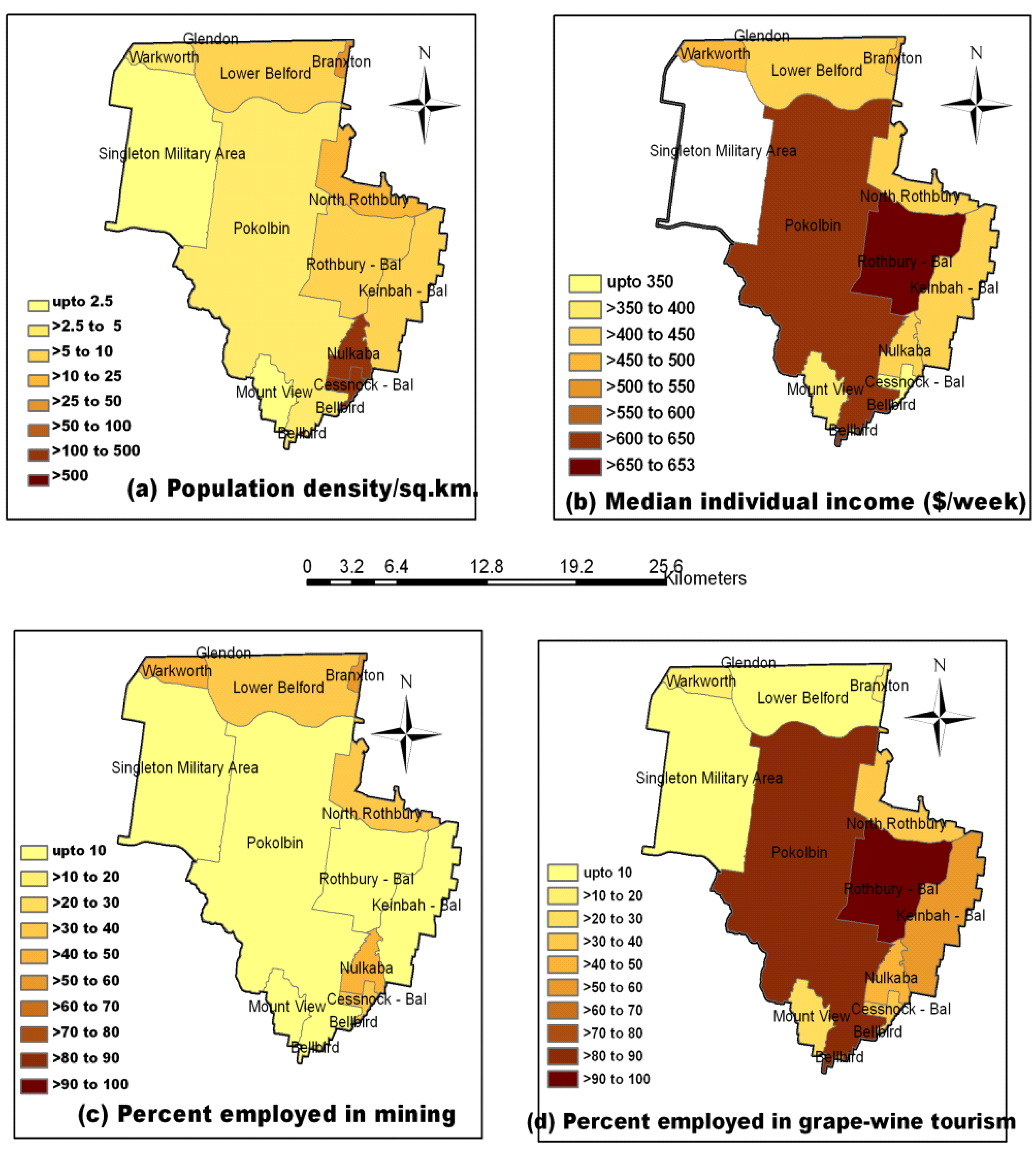
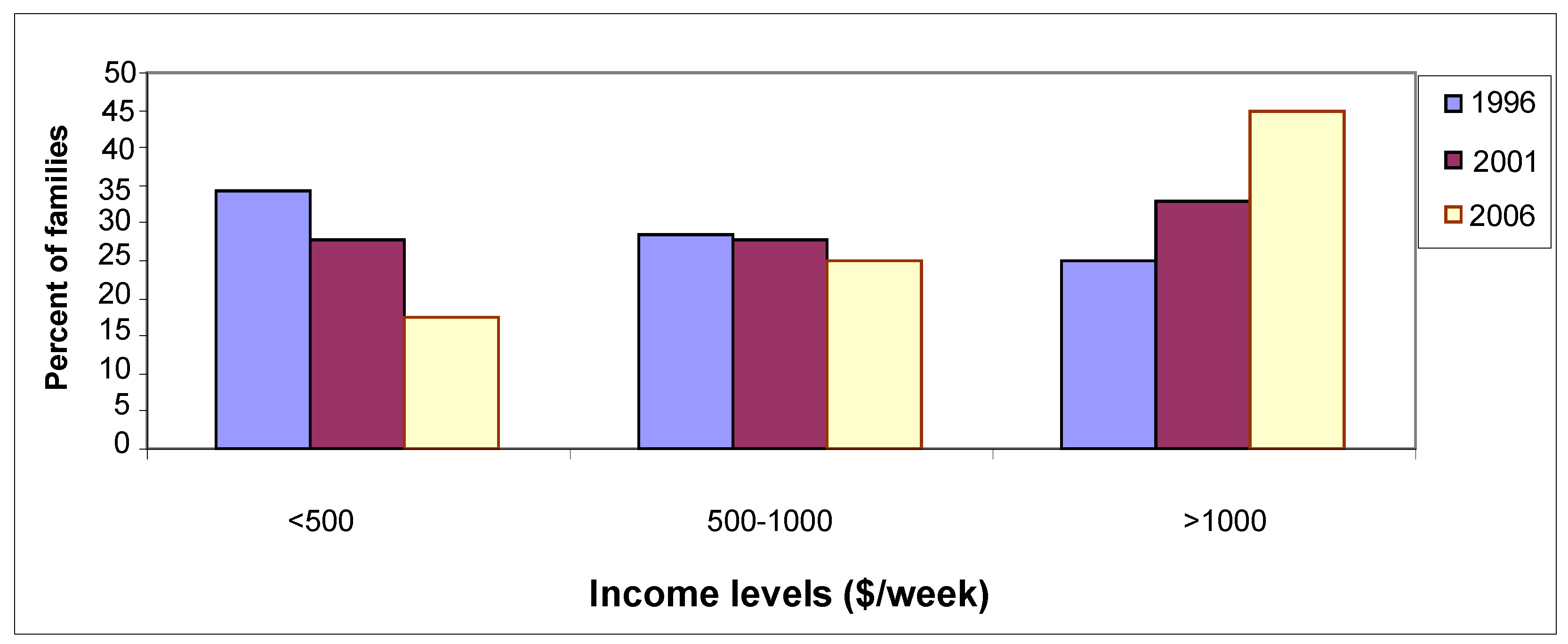
3.5. Linking the Built-up Increase with Economic Development
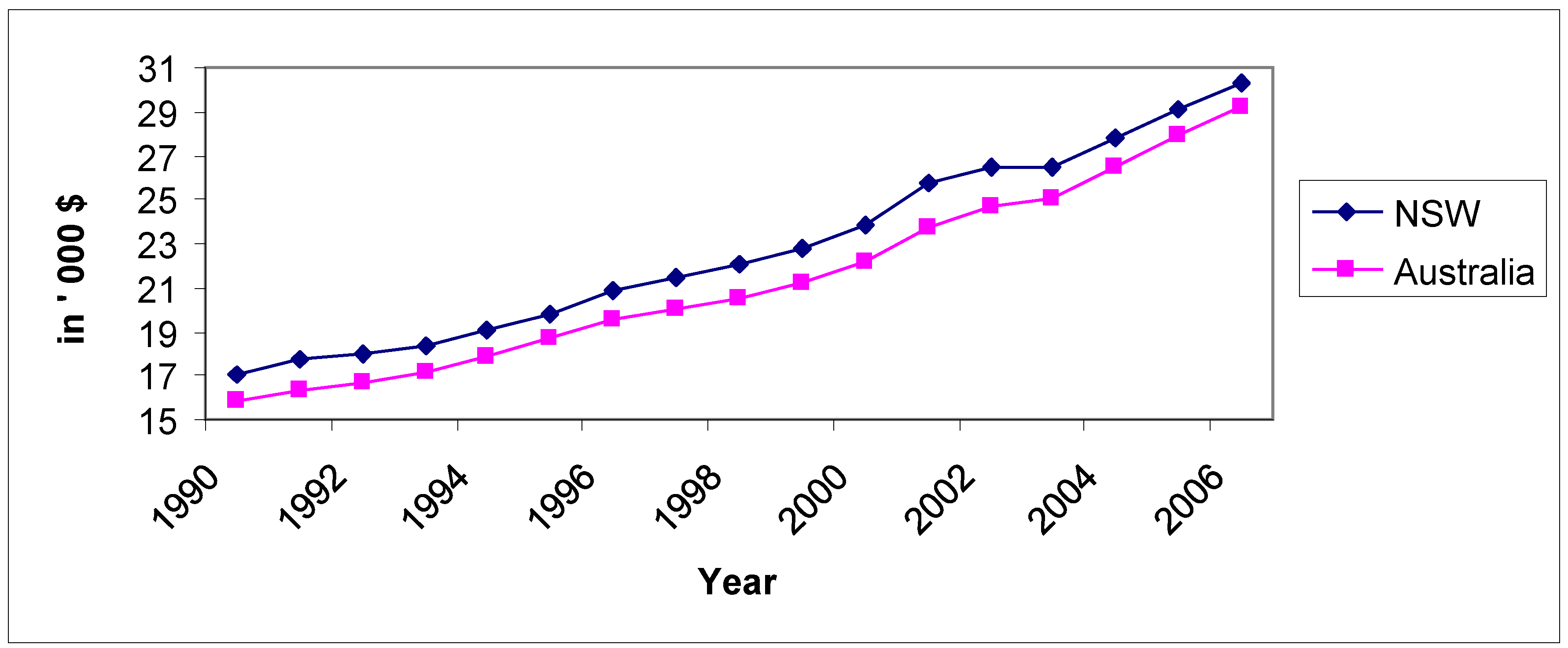
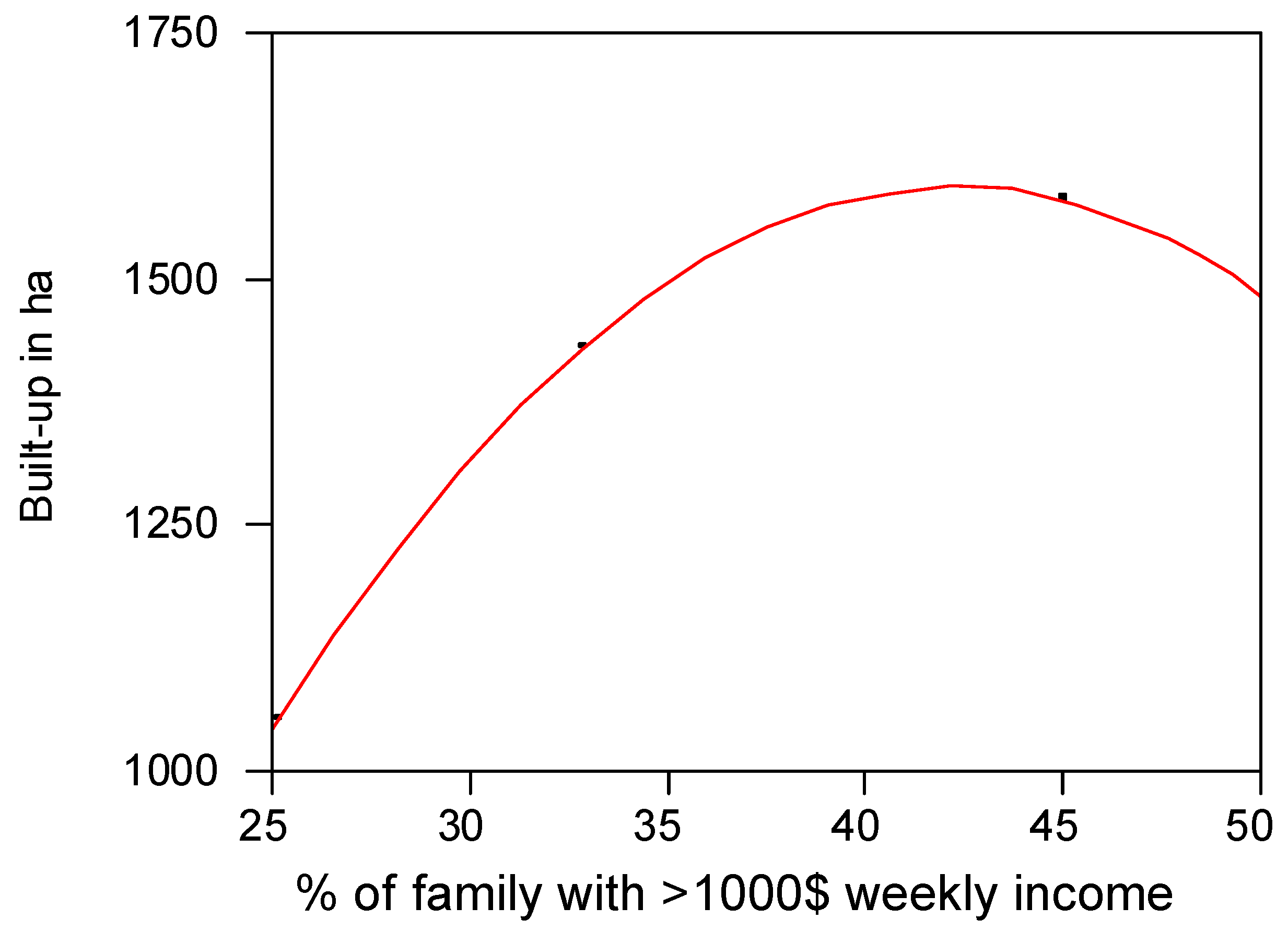
3.6. Contribution of Wine Tourism to the Economy of the Region
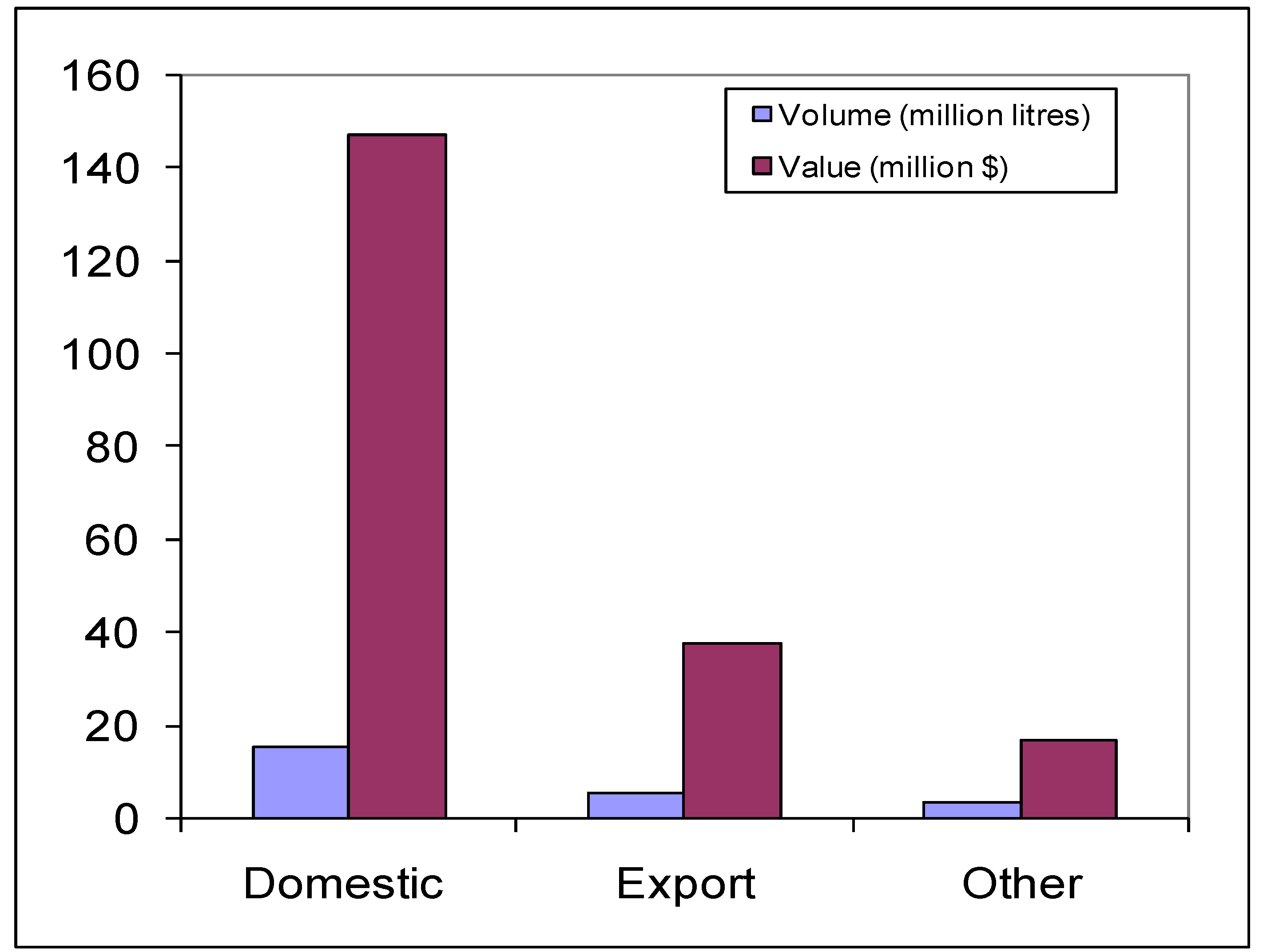
4. Conclusion
Acknowledgments
Author Contributions
Conflicts of Interest
References
- Lambin, E.F.; Geist, H.J.; Lepers, E. Dynamics of land-use and land-cover change in tropical regions. Annu. Rev. Environ. Resour. 2003, 28, 205–241. [Google Scholar]
- Douglas, I. Human settlements. In Change in Land Use and Land Cover—A Global Perspective; Meyer, W.B., Turner, B.L., II, Eds.; Cambridge University Press: New York, NY, USA, 1994; pp. 149–169. [Google Scholar]
- Verburg, P.H.; Schot, P.P.; Dijst, M.J.; Veldkamp, A. Land use change modelling: Current practice and research priorities. GeoJournal 2004, 61, 309–324. [Google Scholar] [CrossRef]
- Wintle, B.A.; Elith, J.; Potts, J.M. Fauna habitat modeling and mapping: A review and case study in the Lower Hunter Central Coast region of NSW. Austral Ecol. 2005, 30, 719–738. [Google Scholar] [CrossRef]
- Ode, A.; Fry, G.A. Model for quantifying and predicting urban pressure on woodland. Landsc. Urban Plan. 2006, 77, 17–27. [Google Scholar] [CrossRef]
- Zeug, G.; Eckert, S. Population growth and its expression in spatial built-up patterns: The Sana’s, Yemen case study. Remote Sens. 2010, 2, 1014–1034. [Google Scholar] [CrossRef]
- Handayani, W. Rural-urban transition in Central Java: Population and economic structural changes based on cluster analysis. Land 2013, 2, 419–436. [Google Scholar] [CrossRef]
- Rees, W.; Wackernagel, M. Urban ecological footprints: Why cities cannot be sustainable—And why they are a key to sustainability. Environ. Impact Assess. 1996, 16, 223–248. [Google Scholar] [CrossRef]
- Kitzes, J.; Galli, A.; Bagliani, M.; Barrett, J.; Dige, G; Ede, S.; Erb, K.; Giljum, S.; Haberl, H.; Hails, C.; et al. A research agenda for improving national ecological footprint accounts. Ecol. Econ. 2009, 68, 1991–2007. [Google Scholar] [CrossRef]
- Lenzen, M.; Murray, S.A. A modified ecological footprint method and its application to Australia. Ecol. Econ. 2001, 37, 229–255. [Google Scholar] [CrossRef]
- Seto, K.C.; Fragkias, M. Quantifying spatiotemporal patterns of urban land-use change in four cities of China with time series landscape metrics. Lands. Ecol. 2005, 20, 871–888. [Google Scholar] [CrossRef]
- Ramankutty, N.; Graumlich, L.; Achard, F.; Alves, D.; Chhabra, A.; Defries, R.S.; Foley, J.; Geist, H.; Houghton, R.A.; Goldewijk, K.K.; et al. Global land-cover change: Recent progress, remaining challenges (Chapter 2). In Land-Use and Land-Cover Change. Local Processes and Global Impacts; Lambin, E.F., Geist, H., Eds.; Springer: New York, NY, USA, 2006; pp. 9–39. [Google Scholar]
- Australian Bureau of Statistics (ABS). Year Book; ABS: Canberra, ACT, Australia, 2007.
- Federal Treasury Office. Third Intergenerational Report as Broadcasted on ABC; Australian Commonwealth: Canberra, ACT, Australia, 18 September 2009.
- Hunter Central River Report Card; Natural Resource Management, NSW State and Territory Coordination, Australian Commonwealth: Canberra, ACT, Australia, 2004.
- Department of planning, NSW government. Lower Hunter Regional Strategy; Department of Planning: Sydney, NSW, Australia, 2006.
- Holmes, J.; Hartig, K. Metropoliton colonization and the reinvention of place: Class polarization along the Cessnock-Pokolbin Fault Line. Geogr. Res. 2007, 45, 54–70. [Google Scholar] [CrossRef]
- Manandhar, R. Spatial-Temporal Analysis of Land Use and Land Cover Transitions in a Regional Centre and Its Precinct. Ph.D. Thesis, University of Sydney, Sydney, NSW, Australia, 2011. [Google Scholar]
- Anderson, J.R.; Hardy, E.E.; Roach, J.T.; Witmer, R.E. A Land Use and Land Cover Classification System for Use with Remote Sensor Data; US Geological Survey-Professional Paper 964; Government Printing Office: Washington, DC, USA, 1976. [Google Scholar]
- ERDAS Field Guide; Leica Geosystems Geospatial Imaging, LLC: Norcross, GA, USA, 2005.
- IDRISI Andes. Land change modeler (LCM) (Tutorial Part 6). In IDRISI Andes Tutorial; Clark Labs, Clark University: Worcester, MA, USA, 2006; pp. 246–267.
- Pontius, R.G.; Huffaker, D.; Denman, K. Useful techniques of validation for spatially explicit land change models. Ecol. Model. 2004, 179, 445–461. [Google Scholar] [CrossRef]
- Atkinson, P.M.; Tatnall, A.R.L. Neural network in remote sensing. Int. J. Remote Sens. 1997, 18, 677–709. [Google Scholar]
- Weng, Q. Land use change analysis in the Zhujiang Delta of China using satellite remote sensing, GIS and stochastic modeling. J. Env. Manage. 2002, 64, 273–284. [Google Scholar] [CrossRef]
- Urban, D.L.; Wallis, D.O. Introduction to Markov model. In Learning Landscape Ecology—A Practical Guide to Concepts and Techniques; Gergel, S.E., Turner, M.G., Eds.; Springer: New York, NY, USA, 2002; Chapter 4; pp. 35–48. [Google Scholar]
- Tang, J.; Wang, L.; Yao, J. Spatio-temporal urban landscape change analysis using the Markov chain model and a modified genetic algorithm. Int. J. Remote Sens. 2007, 28, 3255–3271. [Google Scholar] [CrossRef]
- Pontius, R.G.; Malanson, J. Comparison of the structure and accuracy of two land change models. Int. J. Geogr. Inform. Sci. 2005, 19, 243–265. [Google Scholar] [CrossRef]
- Verburg, P.H.; Kok, K.; Pontius, R.G.; Veldkamp, A. Modelling land-use and land-cover change. In Land-Use and Land-Cover Change. Local Processes and Global Impacts; Lambin, E.F., Geist, H., Eds.; Springer: New York, NY, USA, 2006; pp. 117–135. [Google Scholar]
- Box, G. Robustness in the strategy of scientific model building. In Robustness in Statistics; Launer, R.L., Wilkinson, G.N., Eds.; Academic Press: New York, NY, USA, 1979; pp. 201–236. [Google Scholar]
- Parker, D.C.; Hessl, A.; Davis, S.C. Complexity, land-use modeling, the human dimension: Fundamental challenges for mapping unknown outcome spaces. Geoforum 2008, 39, 789–804. [Google Scholar] [CrossRef]
- Pontius, R.G.; Boersma, W.; Castella, J.C.; Clarke, K.; de Nijs, T.; Dietzel, C.; Duan, Z.; Fotsing, E.; Goldstein, N.; Kok, K.; Kooman, E.; et al. Comparing the input, output, and validation maps for several models of land change. Ann. Reg. Sci. 2008, 42, 11–37. [Google Scholar] [CrossRef]
- Guindon, B.; Zhang, Y.; Dillabaugh, C. Landsat urban mapping based on a combined spectral-spatial methodology. Remote Sens. Environ. 2004, 92, 218–232. [Google Scholar] [CrossRef]
- Australian Bureau of Statistics (ABS). Census of Population and Housing: Cessnock LGA; ABS: Canberra, ACT, Australia, 2006.
- Reserve Bank of Australia. Inflation Calculator. Available online: http://www.rba.gov.au/calculator/annualDecimal.html (accessed on 18 December 2009).
- Australian Bureau of Statistics (ABS). Household Income Account and per Capita, New South Wales: Current Prices (Time Series Workbook); ABS: Canberra, ACT, Australia, 2006.
- Davies, B.; Mangan, J. Family expenditure on hotels and holidays. Ann. Tour. Res. 1992, 19, 691–699. [Google Scholar] [CrossRef]
- Australian Bureau of Statistics (ABS). Household Income Account and per Capita, Australia: Current Prices (Time Series Workbook); ABS: Canberra, ACT, Australia, 2006.
- Australian Bureau of Statistics (ABS). Household Income Account and per Capita, New South Wales: Current Prices (Time Series Workbook); ABS: Canberra, ACT, Australia, 2006.
- Stern, D.I. The rise and fall of the environmental Kuznet curve. World Dev. 2004, 32, 1419–1439. [Google Scholar] [CrossRef]
- vanKooten, G.C.; Folmer, H. Sustainable development and conservation (Chapter 7). In Land and Forest Economics; Edward Elgar Publishing Limited: Cheltenham, UK/Northampton, MA, USA, 2004; pp. 203–241. [Google Scholar]
- O’Mahony, B.; Hall, J.; Lockshin, L.; Jago, L.; Brown, G. Wine Tourism and Subsequent Wine Purchase Behaviour; Cooperative Research Centre (CRC) for Sustainable Tourism Pty Ltd: Adelaide, SA, Australia, 2008; p. 57. [Google Scholar]
- Australian Bureau of Statistics (ABS). Australian Wine and Grape Industry Re-Issue; ABS: Canberra, ACT, Australia, 2008.
- Cooperative Research Centre (CRC) Tourism. Holidays and Wine Regions Survey; Cooperative Research Centre for Sustainable Tourism Pty Ltd: Adelaide, SA, Australia, 2007; p. 82. [Google Scholar]
- Tourism New South Wales (NSW). Wine Tourism Research Cellar Door Survey; Tourism New South Wales Information and Research Unit: Sydney, NSW, Australia, 2002; p. 17. [Google Scholar]
- Cessnock Council. Hunter Valley Wine Country Tourism Related Statistic and Information 2002. Available online: http://www.cessnock.nsw.gov.au (accessed on 20 May 2008).
© 2014 by the authors; licensee MDPI, Basel, Switzerland. This article is an open access article distributed under the terms and conditions of the Creative Commons Attribution license (http://creativecommons.org/licenses/by/3.0/).
Share and Cite
Manandhar, R.; Odeh, I.O.A.; Ancev, T. Assessment of Spatial-Temporal Expansion of Built-up and Residential-Commercial Dwellings with Some Economic Implications: A Case Study in the Lower Hunter of Eastern Australia. Land 2014, 3, 239-259. https://doi.org/10.3390/land3010239
Manandhar R, Odeh IOA, Ancev T. Assessment of Spatial-Temporal Expansion of Built-up and Residential-Commercial Dwellings with Some Economic Implications: A Case Study in the Lower Hunter of Eastern Australia. Land. 2014; 3(1):239-259. https://doi.org/10.3390/land3010239
Chicago/Turabian StyleManandhar, Ramita, Inakwu O.A. Odeh, and Tihomir Ancev. 2014. "Assessment of Spatial-Temporal Expansion of Built-up and Residential-Commercial Dwellings with Some Economic Implications: A Case Study in the Lower Hunter of Eastern Australia" Land 3, no. 1: 239-259. https://doi.org/10.3390/land3010239
APA StyleManandhar, R., Odeh, I. O. A., & Ancev, T. (2014). Assessment of Spatial-Temporal Expansion of Built-up and Residential-Commercial Dwellings with Some Economic Implications: A Case Study in the Lower Hunter of Eastern Australia. Land, 3(1), 239-259. https://doi.org/10.3390/land3010239




